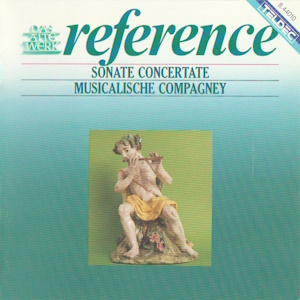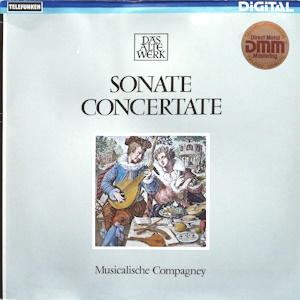 |
| 1 CD -
8.44010 ZS - (C) 1988 |
 |
| 1 LP -
6.42825 AZ - (p) 1982 |
|
SONATE CONCERTATE
|
|
|
|
|
|
|
|
|
|
| Giovanni
Battista BUONAMENTE (17. Jh.) |
Sonata à 6
für 2 Cornetti, 2 Violen, Posaune,
Dulcian, Violoncello, Chitarrone und
Orgel (Venedig 1636)
|
|
5' 07" |
1 |
A1
|
|
Sonata à 3
für Cornetto, Violine, Dulcian,
Chitarrone und Orgel |
|
5' 42" |
2 |
A2
|
| Johann
Heinrich SCHMELZER (um 1623-1680)
|
Sonata "La
Carioletta" à 4 für Violine,
Cornetto, Posaune, Dulcian,
Violoncello, Chitarrone und Orgel |
|
6' 46" |
3 |
A3
|
| Heinrich Aloys
BRÜCKNER (17. Jh.) |
Sonata
à 4 für 2 Violinen,
2Cornettini, Dulcian, Chitarrone und
Orgel |
|
2' 46" |
4 |
A4
|
| Marc'Antonio FERRO
(? - 1662) |
Sonata VII à 4
für Conetto, Violine, Viola,
Dulcian, Chitarrone und Orgel
(Venedig 1649)
|
|
3' 39" |
5 |
A5
|
|
Sonata VIII à 4
für 2 Cornetti, Posaune, Dulcian,
Violoncello und Orgel |
|
3' 28" |
6 |
B1
|
| Giovanni
VALENTINI (1583-1649) |
Sonata à 4
für Violine, Cornettino, Posaune,
Dulcian, Chitarrone und Orgel (ca.
1620)
|
|
5' 50" |
7 |
B2
|
| Johann
Joseph FUX (1660-1741) |
Sonata
à 4 für Violine, Cornetto,
Posaune, Dulcian, Violoncello und
Orgel |
|
8' 31" |
8 |
B3 |
| Giovanni LEGRENZI
(1626-1690) |
Sonata
"La Buscha" à 6 für 2
Cornetti, Dulcian, 2 Violinen,
Violoncello, Chitarrone und Orgel
(Venedig 1663) |
|
4' 14" |
9 |
B4 |
|
|
|
|
|
| MUSICALISCHE
COMPAGNEY |
The Instruments
|
|
- Holger Eichhorn, Zink
(Cornetto 1)
|
Cornetti:
Rainer Weber, 1973 | Roland Wilson,
1979
|
|
| - Roland Wilson, Zink
(Cornetto 2) |
Cornettini:
Rainer Weber, 1976 | Roland Wilson,
1980 |
|
- Thomas Albert, Violine
(1), Viola (1)
|
Violinen:
Jacobus Stainer, Absam, 1680 | Ignaz
Penze, 1772
|
|
- Günter Schlenk, Violine
(2), Viola (2)
|
Violen:
süddeutsch, um 1700 | Friedrich
Hoffman, Leipzig, 1690 |
|
| - Jzrki Lavaste, Posaune |
Posaune: Meinl
& Lauber, 1975 |
|
| - Bernhard Junghändel,
Dulcian |
Dulcian:
Bernhard Junghändel, 1974 |
|
| - Katharina Maechler,
Violioncello |
Violoncello:
Paulus Alletree, 1736, München |
|
| - Stephen Stubbs, Chitarrone |
Chitarrone:
Jacob van der Geest, 1975 |
|
| - Klaus Eichhorn, Orgel |
Orgel:
Anonymus, neapolitanisch, 17. Jh. |
|
|
|
|
|
Luogo
e data di registrazione |
|
- |
|
|
Registrazione:
live / studio |
|
studio |
|
|
Producer /
Engineer |
|
- |
|
|
Prima Edizione
LP |
|
Telefunken
- 6.42825 AZ - (1 LP) - LC 0366 -
durata 46' 57" - (p) 1982 -
Digital |
|
|
Edizione
"Reference" CD
|
|
Tedec
- 8.44010 ZS - (1 CD) - LC 3706 -
durata 46' 57" - (c) 1988 - DDD |
|
|
Cover |
|
"Musiyierender
Satyr", Fayence, Eckernförde 1765.
Museum für Kunst und Gewerbe,
Hamburg.
|
|
|
|
|
The term
sonate concertate
appeared by 1621 at the
latest in the title of
relevant Venetian
editions; the term refer
- unlike the older type
of canzona sonata and
analogous to the modern
concerto - to a special
category of ensemble
sonata: the individual
instruments can, for
example, act as solos,
or they can perform “in
concerto style” quite
different material
within the framework of
the ensemble. These solo
passages are
occasionally set off
from one another by
tutti sections (e.g.
ritornelli), but they
sometimes flow into one
another without a break.
They often give the
impression of being
improvised, particularly
when they are based on
likesounding bass
models. Further
characteristics of the
sonata concertata are
the differentiation of
ripieno and concertino
sections according to
the type of movement and
the choice of motif. The
contrast between upper
and lower choir or
between wind and string
timbre came to have an
idiomatic and structural
significance beyond the
traditional antiphon
singing.
In the course of the
17th century, Vienna
developed into one of
the leading music
centres of Europe under
the supervision and
patronage of the
Habsburg Emperors
Ferdinand II, Ferdinand
III and particularly
Leopold I, all of whom
were extremely fond of
music. These three
rulers encouraged strong
Italian influence in the
court orchestra, and a
distinct
“Austro-Italian” musical
style was founded and
developed under the
Hofkapellmeister G.
Priuli and G. Valentini
and Monteverdi’s pupil
G. B. Buonamente. Almost
all the important
musicians at the court
came from Venice, and
they were nearly all
engaged in the import
and cultivation of
Venetian opera in
Vienna. The definition
of the post-Gabrieli
instrumental style was
the major achievement of
the “Viennese
Venetians”, who may be
listed chronologically
as follows: Priuli,
Valentini, Buonamente,
Bertali, Cesti,
Schmelzer, Fux.
Giovanni Battista
Buonamente, whose
splendid Orchestra
Sonata and five-movement
Trio Sonata are both
notable for their
fertility of
inspiration, was a
musician at the Imperial
Court in Vienna from
1622 onwards. It was his
set of suites and
sonatas, published in
Venice, that brought the
new Italian instrumental
style to Austria.
Johann Heinrich
Schmelzer enjoyed a
considerable reputation
as a virtuoso violinist,
and was the first
Austrian in a long line
of Italian
Hofkapellmeister,
directors of music at
the court. His “Sonata
la Carolietta à 4” is
divided into two fully
worked-out outer
movements and a central
section of virtuoso,
improvisational
character. Here, within
the framework of a tutti
ritornello (3/2 time),
two pairs of instruments
play in each case almost
identical solos one
after the other: violin
and trombone “improvise”
over one repeated bass
line, cornet and dulcian
over another. The work
is only preserved in a
single copy in the St.
Maurizius-Archiv in
Kremsier. Kremsier, the
residence of another
music-loving member of
the aristocracy, the
Prince-Bishop Karl
Liechtenstein-Kastelkorn
of Olmütz, played a key
role in the development
of the magnificent
Viennese-Venetian style.
We know little about the
life of Heinrich Aloys
Brückner. His
three-movement,
two-choir sonata for
four soprano instruments
is also preserved in the
Kremsier archives.
Marc-Antonio Ferro spent
the last twenty years of
his life as a
theorbo-player at the
Imperial Court. The only
works of his to have
survived are a
collection of two-,
three- and four-part
sonatas, compositions
which are marked on the
one hand by conservatism
and on the other by
surprising ideas in the
thematic and harmonic
phrasing.
Giovanni Valentini, like
his predecessor Priuli a
pupil of Gabrieli,
entered the court
orchestra in Graz in
1614 after ten years as
organist to the King of
Poland. When the
Archduke was to be
crowned Emperor
Ferdinand II, he moved
to Vienna together with
the orchestra, and here
he was promoted to the
position of
Hofkapellmeister in
1629. Idiosyncracies in
the form and sound of
his works show that he
always strove to write
individual music in
spite of his own strong
traditional streak.
Johann Joseph Fux is
represented here by his
“ Sonata a quattro”, a
sonata da chiesa of a
rather anachronistic
kind. The cornet and the
trombone, for example,
were universally
considered oldfashioned
in classical music by
Fux’s time.
The “modern”
instruments, violin and
bassoon, are also
employed differently in
places - in the
“concertante” insert in
the middle of the second
movement, for example.
The third part of this
movement is a
masterpiece of
counterpoint: three to
four subjects are
impressively handled.
The third movement, a
full-sounding adagio
rich in dissonance,
leads directly into the
fourth movement; the
time marking is not
altered by the
transition, unlike the
quality of the phrasing.
The fifth movement is
once again split into
three parts. In spite of
the austere double and
triple fugues, the work
is attractive for its
melodic intimacy and the
beauty of the sound.
This sonata is the late
crowning of a tradition
of scoring for violin
and wind instruments
which survived with
vigour until the
beginning of the 18th
century, despite the
predominance of music
for string ensemble.
Giovanni Legrenzi does
not belong properly to
the “Viennese
Venetians”. Ambitious in
his career, Legrenzi
advanced through various
posts to be appointed
maestro di capclla at
San Marco in Venice at
the age of 58; neither
dedicatory compositions
on his part, however,
nor the generous
recommendations of
others were able to
secure him the
equivalent position at
the Vienna court.
The selection of sonatas
on this record
represents two different
traditions of sonata a
quattro scoring apart
from the two pieces by
Buonamente. One is a
mixed instrumentation
with cornet, violin,
trombone and bassoon;
the other is the
double-choir combination
consisting of two
groups, each with two
soprano instruments and
a bass continuo, the
latter also being
chorally divided in
places. These ensemble
pieces are without
exception sonate da
chiesa, albeit in most
cases no less expressly
intended for camera than
chiesa.
Holger
Eichhorn
Translation:
Clive R. Williams
The Musicalische
Compagney, anensemble
devoted to music of the
16th amd 17th centuriesm
was founded in 1972 by
Holger Eichhorn
(cornettist and
musicologist) and Klaus
Eichhorn (church
musician). Taking as a
working title "An
experiment in the real
way to play historic
music", the group
strives to reconcilie a
historically accountable
- i. e. intellectually
appropriate -
presentation of the
correlation of timbre,
delivery and emotional
expression with actual
performance. The
Musicalische Compagney
had cosolidated its
reputation as a rather
special ensemble with
numerous concerts in
Germany and abroad
(Belgium, Denmark, East
Germany, France,
Holland, Italy, Austria,
Switzerland, USA...),
and with radio and
television broadcasts
and gramophone
recordings, Among the
major events in their
work in recent years
have been an hour-long
television film, the
first performance of
Monteverdi's "Vespers"
in the conjectural
original version and an
annual series of
concerts which the group
has now given several
years running.
|
|